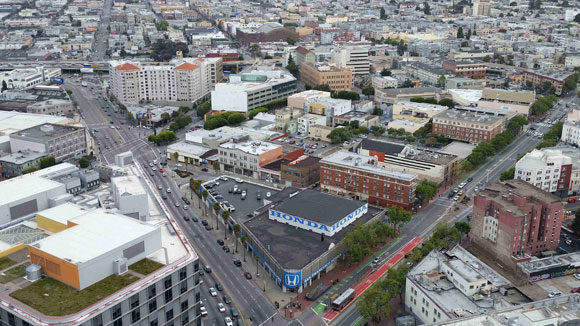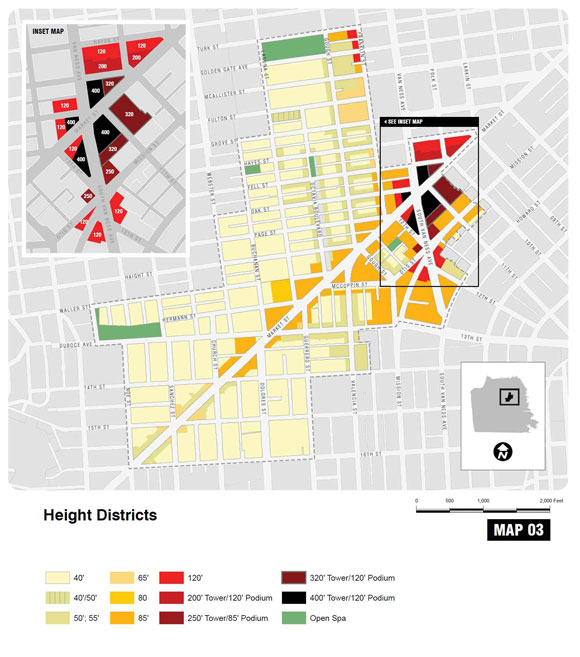How Freeway Removal and Zero Parking Can Fend Off SF’s Triple Threat
3:34 PM PDT on May 26, 2015

There is an urgent triumvirate of crises looming over San Franciscans. With median rents now exceeding $4,200, hyper-gentrification is tearing lives apart. Except for those surviving on rent control, the city is no longer welcoming to teachers, artists, and the entire middle class. Things are looking difficult in the East Bay, as speculators and realtors spread their tentacles of greed around every BART station.
Meanwhile, on the city’s streets there’s an onslaught of untenable motor traffic, visionless drivers imposing violence and rage on the streets, Ubers blocking bike lanes, private buses grabbing Muni stops. It’s not just hard to get around. It’s deadly.
And in the back of every decent thinking person’s mind there’s the specter of climate change. What kind of Mad Max world comes with a 4° increase in global mean temperatures? How can we stabilize at 2°? Will the Bay Area be viable as Sierra snowpack dries up and the seas rise? What can we do here? Now?
Many people feel despondent at what is unfolding. In San Francisco, a proposed moratorium on new market rate development in the Mission has gained traction and will be vetted at the Board of Supervisors. In Oakland, a city hall meeting was bum rushed and shut down by activists.
Sustainable transportation activists push a Vision Zero agenda to tame traffic but the mayor defends parking over human lives. And affordability and the traffic mess are tangled up in a planning quagmire, with the impotent Plan Bay Area the only coherent climate strategy in town.
There’s a lot to grapple with here, and not much time to make a difference. But lately a few planning ideas -- zero parking, freeway removal, and upzoning for affordability -- have come to my mind as ways we can quickly, practically, and deliberately address this converging madness -- right here, right now.
It all starts with a proposal made a few weeks ago by the city planning department to "upzone" parts of the city in order to engineer more affordable housing. Specifically, the planning department is eyeing a potential height and density increase in part of the Market and Octavia Plan area, located in the center of San Francisco, and specifically in the corridor from Market Street down South Van Ness and Mission/Otis Streets.

The impetus for this rezoning proposal comes from last year’s Proposition K, approved by San Francisco voters with encouragement from the mayor and supervisors. Proposition K calls for 33 percent of housing to be reserved for subsidized rental units when parts of the city are “upzoned” for new infill housing and development. The idea is that in exchange for lucrative height and density increases, developers provide affordable housing on site.
The trick is to find viable areas to rezone, both physically and politically, and few opportunities exist. But the eastern half of the Market and Octavia Plan area might just work. It is a decidedly forlorn and unlivable part of the city with mostly low-rise automobile dealerships or light industrial land uses mixed with some residences here and there. There are large parcels that, if upzoned, have great promise to bring more affordable housing to the central part of the city.
But there’s a catch. Rezoning height and density requires a lengthy environmental study that can take up to two or three years to complete. In this affordability crisis, we don’t have time for that. Moreover, many of the parcels in this area, including at least 1,600 units proposed in five high-rise towers at Market and Van Ness, are already in play, with developers lining up and submitting applications to build.
There might be a way around part of the time barrier of CEQA. As Streetsblog readers may know, this part of the city was rezoned in 2009 with groundbreaking parking reform. The Market and Octavia Plan (and Eastern Neighborhoods just to the south) dispensed with conventional parking standards and eliminated parking minimums, while capping the ratio of parking spots to residences below 1-to-1.
And get this: All of this parking reform has already undergone extensive environmental review.
So the city might be able to immediately begin to rezone this area for zero parking. It may take some legal finessing and courage, but it is worth pursuing quickly. By banning parking, the attraction for luxury development is dampened, and the added cost parking brings to new condos is no longer part of the equation.
Zero parking might not create deep affordability, but it certainly will recalibrate the entire financial calculus of development, perhaps putting more new residences within reach for the middle class.
Zero parking will also be in line with the city’s Vision Zero goals. Consider that under the current, albeit reformed, parking ratios, upwards of 900 parking spaces might be built within one block of the intersection of Market and Van Ness. This is based on existing development proposals -- none yet approved -- and, sadly, we see that few of the large-scale developers are exercising the car-free option they are allowed under Market and Octavia.
That much parking will exacerbate the already saturated traffic conditions in the city center, which is burdened with congestion on Van Ness Avenue and on a handful of multilane arterials called “one-way couplets.” Developers are seeking maximum profit from luxury housing attached to luxury parking. This is a recipe for what planning scholar Peter Hall has called a “Great Planning Disaster!”
So as a first step toward rezoning for affordability, let’s rezone for zero parking and steer the current round of development toward our long-term sustainable transportation and climate change goals.
There’s another big idea that’s within reach. We need to take down the rest of the Central Freeway, which, like zero parking, has numerous benefits for addressing the triumvirate of crises. Removal of the freeway would free up many acres of land that can be dedicated to affordable housing, and adjacent surface parking lots could also be converted to housing.
From a traffic perspective, touching the freeway down at Bryant provides more opportunities to disperse traffic than channeling it on a clogged freeway and into Hayes Valley. There are also a plethora of obvious air quality, noise, and livability benefits.
Most significantly, this freeway WILL COME DOWN. The remaining segment of the freeway is 56 years old. It is a seismic albatross and to fix it will require closing it. Why not just tear it down and reboot? In 2004, the San Francisco Board of Supervisors came to this same conclusion with a resolution calling for studying removal. The Market and Octavia Plan also calls for this study. It’s time to get on with it, and fold it into the planning department’s idea to rezone for height and density in exchange for affordability.
There is an urgent triple-crises of affordability, traffic, and climate change leadership at hand. San Francisco can create a low carbon, car-free affordable housing model right here, right now. Let’s do it!
Stay in touch
Sign up for our free newsletter




